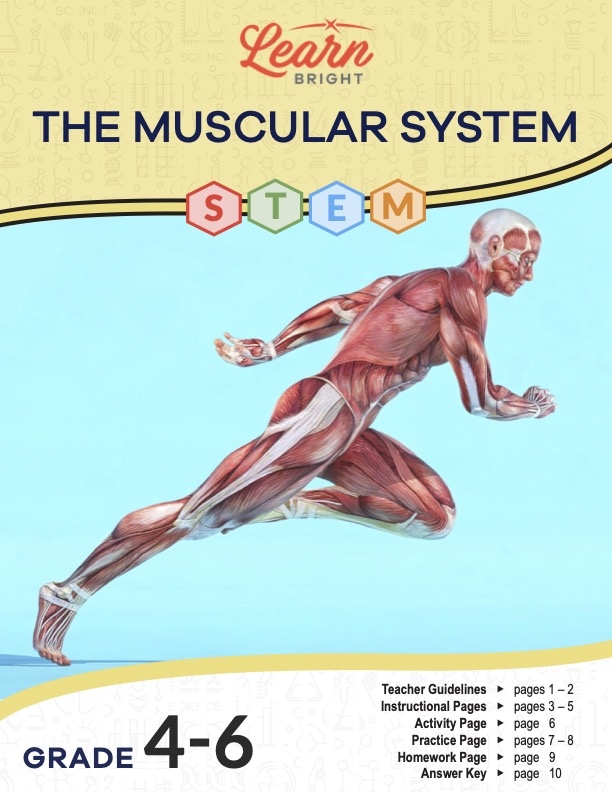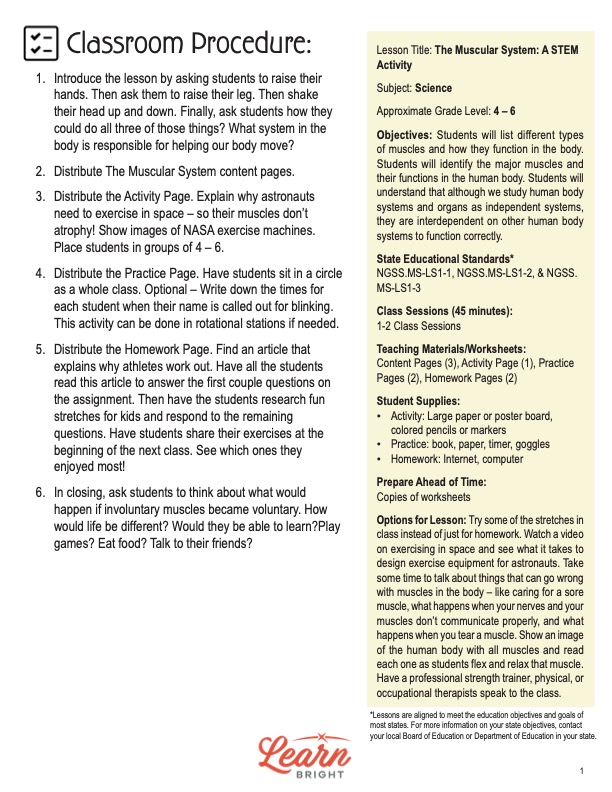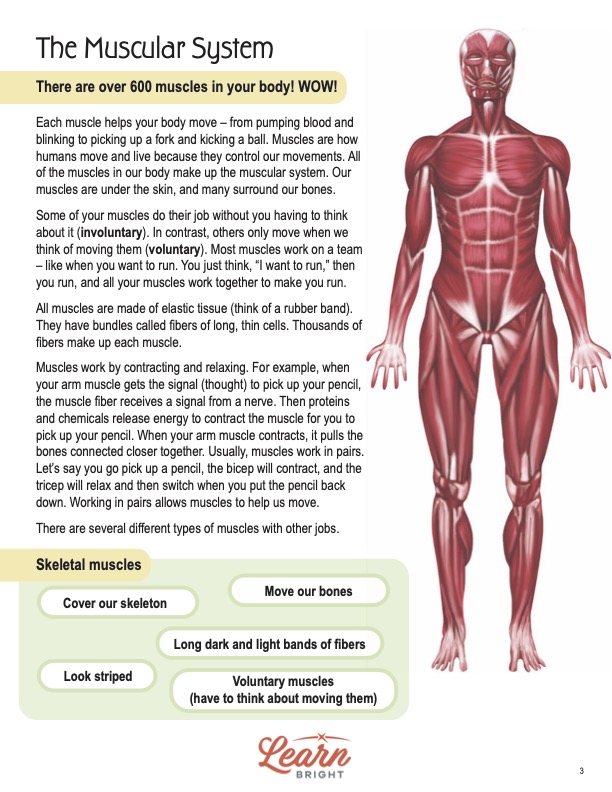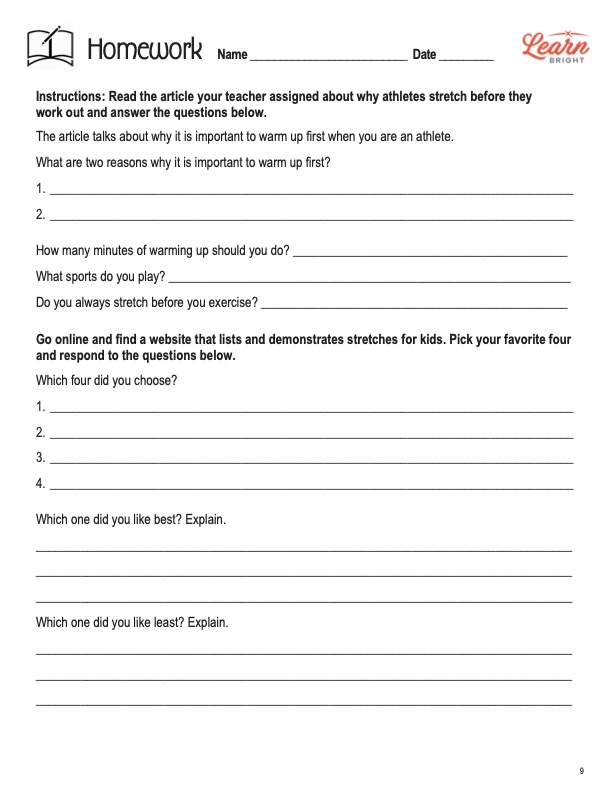Description
What our Muscular System STEM lesson plan includes
Lesson Objectives and Overview: Muscular System STEM explores various types of muscles and how they function in the body. Students will discover several major muscles and explain where they are. They will also learn how various body systems all work together to help us function correctly. This lesson is for students in 4th grade, 5th grade, and 6th grade.
Classroom Procedure
Every lesson plan provides you with a classroom procedure page that outlines a step-by-step guide to follow. You do not have to follow the guide exactly. The guide helps you organize the lesson and details when to hand out worksheets. It also lists information in the yellow box that you might find useful. You will find the lesson objectives, state standards, and number of class sessions the lesson should take to complete in this area. In addition, it describes the supplies you will need as well as what and how you need to prepare beforehand. For this lesson, you will need large paper or poster boards, colored pencils, markers, books, paper, timers, and goggles. Students will also need access the internet for the homework assignment.
Options for Lesson
In the “Options for Lesson” section of the classroom procedure page, you will see some suggestions for additional activities or ideas to add to the lesson if you want to. One idea is to try some stretches in class instead of having students just find them for the homework assignment. You could also watch a video on exercising in space and see what it takes to design exercise equipment for astronauts. Take some time to talk about things that can go wrong with muscles in the body. You could discuss caring for a sore muscle, what happens when your nerves and your muscles don’t communicate properly, or what happens when you tear a muscle. Another option is to show an image of the human body with all muscles and read each one as students flex and relax that muscle. One last option is to have a professional strength trainer or physical or occupational therapist speak to the class and answer questions.
Teacher Notes
The paragraph on this page provides a little more information or guidance on what to expect from the lesson. You can use the blank lines to record any thoughts or ideas you have as you prepare.
MUSCULAR SYSTEM STEM LESSON PLAN CONTENT PAGES
Over 600 Muscles
The Muscular System STEM lesson plan contains three content pages. Each muscle we have helps our body move, from pumping blood to blinking to picking up a fork to kicking a ball. Muscles are how humans move and live because they control our movements. All of the muscles in our body make up the muscular system. Our muscles are under the skin, and many surround our bones.
Some of our muscles do their job without our having to think about it (involuntary). In contrast, others only move when we think of moving them (voluntary). Most muscles work on a team, which is the case when we want to run, for instance. We just think, “I want to run,” and then we run, and all the necessary muscles work together to make it happen.
All muscles are made of elastic tissue (like a rubber band). They have bundles of long, thin cells called fibers. Thousands of fibers make up each muscle. Muscles work by contracting and relaxing. For example, when the arm muscle gets the signal (thought) to pick up a pencil, the muscle fiber receives a signal from a nerve. Then proteins and chemicals release energy to contract the muscle to actually pick up the pencil.
When the arm muscle contracts, it pulls the bones that are connected closer together. Usually, muscles work in pairs. If we go to pick up a pencil, the bicep will contract, and the tricep will relax. Then the two switch when we put the pencil back down—the bicep relaxes while the tricep contracts. Working in pairs allows muscles to help us move.
Types of Muscles
There are several different types of muscles with other jobs. Skeletal muscles cover the skeleton and move our bones. They look striped and consist of long dark and light bands of fiber. These muscles are voluntary, so we have to think about moving them before we actually can. These include deltoids, abdominals, biceps, and quadriceps.
Smooth muscles don’t connect to bones. They control organs in the body and look like sheets or layers of muscle. They are also involuntary, so we don’t have to think about moving them. We would find smooth muscles in the digestive system, heart, eyes, and bladder. Finally, cardiac muscles are the ones that pump the heart.
While these are the main three types of muscles, we also have face muscles. There are over 40 different kinds of muscles in the human face. When we look in a mirror and make a funny face, we can watch the facial muscles contract and relax. Many face muscles are attached under the skin, so we can make many different faces!
Let’s not forget that slimy muscle in the mouth—our tongue! It may surprise students to learn that the tongue is actually a group of muscles that work together to help us talk and chew you food. Of course, we shouldn’t do those two actions at the same time! The tongue muscle is only attached at one end.
Muscle Memory and Atrophy
The last things the lesson discusses are the concepts of muscle memory and muscle atrophy. When we do an action repeatedly, we develop what is called muscle memory. That means the muscle “remembers” what to do and can become more precise in its movement the more often we repeat the movement.
This helps people become more skilled at certain activities, such as a basketball player making free throws or a ballerina spinning around. The more they practice the same movements over and over, the more consistent they will be. When we exercise, muscles can grow bigger, become flexible, and get stronger. However, if we don’t use our muscles, they can atrophy or become weak. That’s why it is essential to move the body every day!
MUSCULAR SYSTEM STEM LESSON PLAN WORKSHEETS
The Muscular System STEM lesson plan includes three worksheets: an activity worksheet, a practice worksheet, and a homework assignment. Each one will reinforce students’ comprehension of lesson material in different ways and help them demonstrate when they learned. Use the guidelines on the classroom procedure page to determine when to distribute each worksheet to the class.
STRENGTHEN THAT MUSCLE ACTIVITY WORKSHEET
Students will work in groups for the activity. First, they will read a short paragraph about how astronauts’ muscles often grow weak (atrophy) in space because of the lack of gravity. NASA has asked the students to design a new exercise machine for astronauts. Students will look up different kinds of skeletal muscles and choose one for which their group will design an exercise machine.
After they choose a muscle, students will write it on the line provided on the worksheet. Then they will brainstorm ideas for exercises that could strengthen the muscle they chose. Finally, they will design the machine and draw a picture of it in the box on the worksheet.
BLINKING EXPERIMENT PRACTICE WORKSHEET
The practice worksheet requires students to work with a partner. Each partner will take turns reading a book or doodling for one minute. While partner one reads, partner two will count how many times partner one blinks naturally, and vice versa. After both students have a chance to draw, they will fill in the blank of the conclusion statement.
Next, the whole class will compete in a staring contest. If anyone catches someone blinking, they will call it out. Again, students will respond to the conclusion prompt. Then students will again pair up for the final task. Partner one will wear goggles, and partner two throw balled-up paper at Partner one 10 times. Partner two will record how many times Partner one blinked and did not blink. Then they switch places and repeat.
Finally, students will respond to the prompts at the bottom of the page about blinking being both a voluntary and involuntary muscle action. The last prompt asks them to explain in their own words why this is possible.
MUSCULAR SYSTEM STEM HOMEWORK ASSIGNMENT
For the homework assignment, students will read an article you assign them about why athletes stretch before they work out. They will answer four questions about the article. Then they will go online and find a website that lists and demonstrates different stretches for kids. After picking their favorite four, students will respond to the prompts on the bottom half of the page.
Worksheet Answer Keys
The lesson plan includes answer keys for the practice and homework worksheets. The correct answers are in red to make it easy for you to compare them to students’ work. Some of the prompts are objective, so students responses will vary on those. If you choose to administer the lesson pages to your students via PDF, you will need to save a new file that omits these pages. Otherwise, you can simply print out the applicable pages and keep these as reference for yourself when grading assignments.










